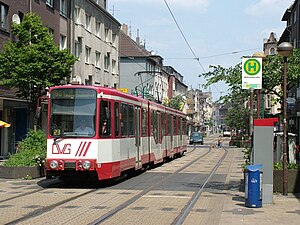DVG GT 10 NC-DU
| DVG GT 10 NC-DU | |
|---|---|
|
GT 10 NC-DU number 1029 in Duisburg-Marxloh
|
|
| Manufacturer: | DUEWAG |
| Year of construction (s): | 1986-1993 |
| Gauge : | 1435 mm ( standard gauge ) |
| Length: | 32,640 mm |
| Empty mass: | 35.4 t |
| Top speed: | 60 km / h 65 km / h in automatic line guidance (ALF) |
| Power system : | 750 V = |
| Power transmission: | Overhead line |
| Seats: | 62 |
| Standing room: | 114 |
| Floor height: | 780 mm (high floor) 280 mm (low floor) |
The GT 10 NC-DU is a ten-axle railcar type of the tram operated by the Duisburger Verkehrsgesellschaft (DVG). It is based on the eight-axis original GT 8 NC-DU version . This articulated wagon is specially designed for the Duisburg rail network with a narrow car body width of 2.2 meters.
Development and history
A new type of car was required for the commissioning of the light rail tunnel in downtown Duisburg on July 11, 1992. The following basic properties should come into play:
- Bi-directional vehicle with doors on both sides of the vehicle
- LZB-capable
- Car body width not greater than 2.2 meters
- Chopper control
The tried and tested N8C light rail car , which has been on the market since the early 1970s, was out of the question for the Duisburg network because it was too wide of 2.3 meters. The reason for this decisive restriction was the small track center distance in some places and narrow track radii at various points (including in Ruhrort between Karlstrasse and Tausendfensterhaus along line 901).
In 1984 the DUEWAG wagon factory in Düsseldorf received the order to build the first 14 vehicles, still in the original eight-axle version. The appearance is based heavily on the type B80C light rail vehicles . However, compared to these, the vehicle has two joints instead of one. In order to be able to test the technical properties of this type in daily use beforehand, an eight-axle articulated wagon (wagon number 1000) from 1966 was fitted with a chopper control after a fire damage; in 1994/95 the conversion to a bidirectional wagon with new fronts followed. In 1996, this car was extended to a ten-axle vehicle with a converted GT8 center section with a low-floor entry.
In 1986 the delivery of the first series of the GT 8 NC-DU (car numbers 1001-1014) began. It was initially used on lines 901 and 904, more rarely on line 909. With the closure of the Mülheim Rathaus loop in 1987 and its conversion to a stump terminal , the use of this bidirectional vehicle on line 901 became mandatory. The sweeping system at the zoo then also required two-way vehicles.
After the opening of the tram tunnel in downtown Duisburg in 1992, the model became the standard vehicle for the tram lines 901, 902 and 903. Already a short time after the conversion to the GT 8 NC-DU, massive capacity problems became noticeable. So the DVG decided to extend the fleet, which has now grown to 45 vehicles, by means of a low-floor middle section.
The conversion began in 1996 with car 1045 and was carried out in the order backwards until 1997. The carriages now length was 32.64 meters, the name changed in GT 10 NC DU ( G élénk t railcars, 10 -achsig, N ormalspur, C hopper control, Du isburger custom made). The permissible top speed was reduced to 60 km / h as a result of this conversion. As with the other members of this vehicle family, this had previously been at 70 km / h.
Due to delivery problems with the new Siemens Combino car type , cars 1001, 1002 and 1003 were loaned to Amsterdam from 1999 to 2002 . There the cars were used in the active scheduled service of the GVB .
Modifications
In addition to the already mentioned extension to the ten-axle vehicle, numerous modifications have been carried out over the years, here is a non-chronological selection:
- Replacement of the round headlights with square halogen headlights , as well as the individual, round diffusers for the rear and brake lights with square LED light units (continues). The third white light on the roof is gradually being replaced by white LEDs.
- Matrix displays instead of scrolling displays
- Installation of a bench with three seats behind each driver's cab
- Digital stop display in the high and low-floor middle section
- Replacement of the synthetic leather seats for hard shell seats (some with fabric cover)
- Video surveillance
Existing cars
Status: 2020
- Car number 1000
- Year of construction 1986: 1002–1007, 1009–1014, 1008 retired due to corrosion damage
- Year of construction 1988: 1015-1016, 1018-1025. 1017 scrapped May 2020.
- Year of construction 1991: 1026-1035
- Year of construction 1992: 1036-1038, 1040. 1039 scrapped in May 2020.
- Year of construction 1993: 1041-1045
literature
- Contemporary witness exchange Duisburg eV: The Duisburg tram , Erfurt 2014, ISBN 978-3-95400-361-7
Web links
- Tram Duisburg (private side)

